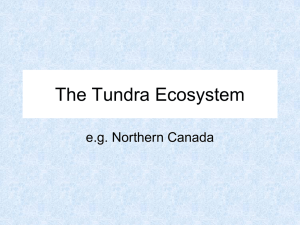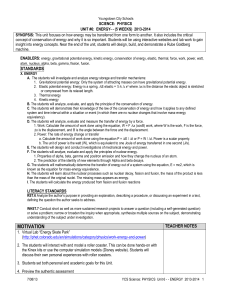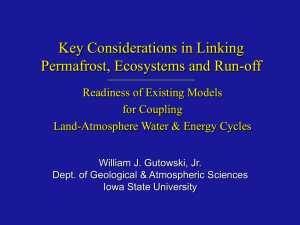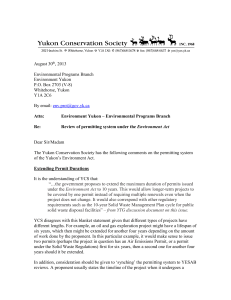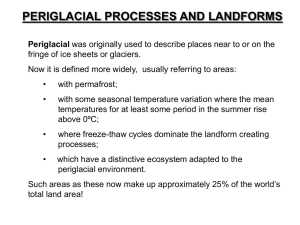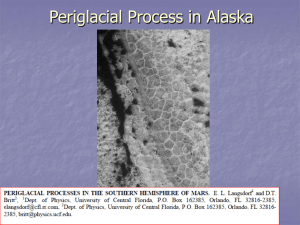November 20th, 2015 Yukon Environmental and Socio
advertisement
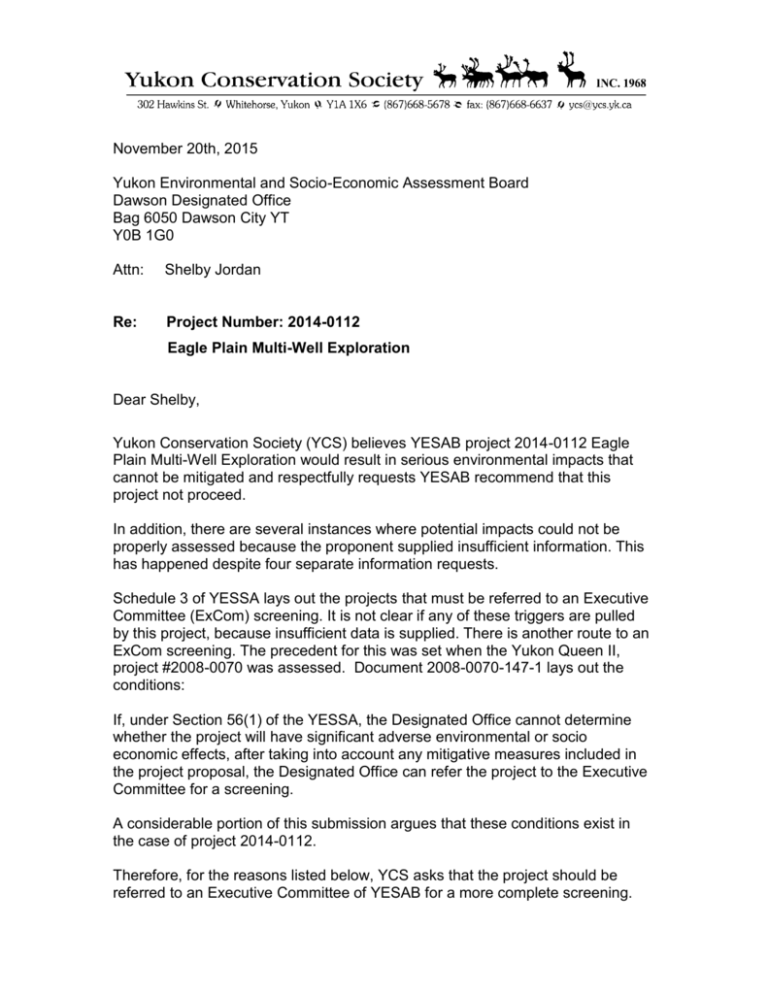
November 20th, 2015 Yukon Environmental and Socio-Economic Assessment Board Dawson Designated Office Bag 6050 Dawson City YT Y0B 1G0 Attn: Shelby Jordan Re: Project Number: 2014-0112 Eagle Plain Multi-Well Exploration Dear Shelby, Yukon Conservation Society (YCS) believes YESAB project 2014-0112 Eagle Plain Multi-Well Exploration would result in serious environmental impacts that cannot be mitigated and respectfully requests YESAB recommend that this project not proceed. In addition, there are several instances where potential impacts could not be properly assessed because the proponent supplied insufficient information. This has happened despite four separate information requests. Schedule 3 of YESSA lays out the projects that must be referred to an Executive Committee (ExCom) screening. It is not clear if any of these triggers are pulled by this project, because insufficient data is supplied. There is another route to an ExCom screening. The precedent for this was set when the Yukon Queen II, project #2008-0070 was assessed. Document 2008-0070-147-1 lays out the conditions: If, under Section 56(1) of the YESSA, the Designated Office cannot determine whether the project will have significant adverse environmental or socio economic effects, after taking into account any mitigative measures included in the project proposal, the Designated Office can refer the project to the Executive Committee for a screening. A considerable portion of this submission argues that these conditions exist in the case of project 2014-0112. Therefore, for the reasons listed below, YCS asks that the project should be referred to an Executive Committee of YESAB for a more complete screening. General Concerns: All petroleum projects need to be considered in a global context. This context includes the reality of global warming, which is mostly driven by the use of fossil fuels. According to the journal Nature, to avoid the worst effects of global warming, three quarters of global undeveloped fossil fuel reserves must remain in the ground. http://www.nature.com/nature/journal/v517/n7533/full/nature14016.html The report concludes that no country’s Arctic energy resources can be developed if global temperature increases are to be kept below 2OC. To quote from the report: “Our results show that policy makers’ instincts to exploit rapidly and completely their territorial fossil fuels are, in aggregate, inconsistent with their commitments to this temperature limit. Implementation of this policy commitment would also render unnecessary continued substantial expenditure on fossil fuel exploration, because any new discoveries could not lead to increased aggregate production”. Consideration of the implications of developing fossil fuel reserves in Yukon must include the cumulative effects of doing so, and the climate effect of carbon must be the mother of all cumulative effects. In other words, approval of this project is not consistent with the climate goals of Yukon, Canada and the world. The quarter of global fossil fuels that can be used, continues the report, must be from sources that are accessible and require lower amounts of energy to extract. This means that “extreme petroleum” such as that from the Arctic cannot be developed. Eagle Plain being in a remote, far northern, low infrastructure environment, falls squarely into this category. During the course of this assessment, leaders from around the world will gather in Paris to work out how to keep global warming from accelerating out of control. Any recommendation other than that this project be rejected will contribute to the worst environmental crisis in history. YCS is aware that YESAB is currently constrained to considering local effects on projects, despite wording in YESSA that could be interpreted otherwise. YCS argues that, unlike project 2013-0115, this is a local project. YCS respectfully requests that YESAB reject this project because its effects are likely to exacerbate global warming. Specific Concerns: Wildlife YCS is concerned that the Wildlife Management Plan submitted by NCY is deficient in many respects. The deficiencies are listed below in detail. Our recommendation follows. Page 2: Mitigation is defined as “minimize disturbance of focal wildlife species” and monitoring will “be used to assess the effectiveness of these measures”. Herein lies the first problem. Mitigation should be viewed more broadly: it should be viewed as a way to eliminate or, if that is not possible, to minimize and compensate for the effects of the project on all fauna and flora. Focal species (Moose, Caribou and Bear) is a very limiting definition and merely to minimize disturbance is not good enough. Monitoring should similarly be broadened to deepening the knowledge about the flora and fauna being monitored, not simply in the context of this project’s effects. The rationale for widening the definition of monitoring is to provide additional knowledge about the species being monitored. A broader view of monitoring could inform the industry and its regulators about best management practices and add to the baseline knowledge for use in potential future projects. This benefit is mentioned in the plan objectives, yet the content does not follow through. In other words, a monitoring program should be designed that acts like an ecological assessment of the area as well as an assessment of the effects of the project and any mitigation identified. Page 4: The Porcupine Caribou Management Board (PCMB) is a comanagement body rather than an advisory board; it was constituted as part of an international agreement around the Porcupine Caribou Herd (PCH) and predates the advisory boards set up in the Final agreements. PCMB concerns must therefore be treated as more than mere “advice” that can be safely ignored. Page 5: YCS is pleased that the mitigation measures are to be viewed as adaptive; if they are shown, through the monitoring program, to be ineffective, they will be changed. YCS is less thrilled that the monitoring program is qualitied by the need to conserve limited company resources. This project can be seen as a bellwether project in Yukon in general and in Eagle Plain in particular. The proponent is owned by one of the wealthiest entities on the planet, the China National Offshore Oil Corporation (CNOOC), in turn owned by the government of the People’s Republic of China. This organization can certainly afford a first class wildlife mitigation and monitoring project, and if it is interested in pursuing further work, and in the general development of the industry, it would be well advised to pull out all the stops and make this project a world class example of how to do it right. YCS asks that the term “stakeholders in the area” be broadened to include Yukon stakeholders generally, and specifically include the Gwitchin Tribal Council (GTC). Interpreted narrowly, this phrase could restrict area stakeholders to permanent residents of Eagle Plains Lodge. The weekly summary should include general observations and have some provision for the inclusion of traditional knowledge (TK). YCS is concerned that YG’s Oil & Gas (O&G) manager will be the YG person responsible for the review and comments on the wildlife monitoring program. It is logical that someone with expertise in wildlife monitoring and mitigation (i.e. from Environment Yukon) be assigned to this file. Page 7: A list of sensitive habitats is provided that will be avoided to the extent possible. Buffers will be placed around specific sites such as nests, dens etc. according to best management practices (BMP) industry-wide or in Yukon. YCS suggests that “whichever is the more rigorous” be added to this sentence. For example, Yukon does not have any territorial wetland protection measures. Wetlands cover 25-50% of the project area (Jacobsen 2007). Page 8: Access roads should not only be gated, but, during times when caribou are present, they should be manned. Surveys for nesting birds should be conducted by qualified experts, as nests are cryptic, i.e. they are intended to be hard to find. Page 10: Riparian areas are considered to be “sensitive” (page 7) and to be avoided to the extent possible, therefore it is a concern that there is talk of reclamation of sensitive areas. Additionally, all disturbed areas ought to be reclaimed. Page 12: Caribou mitigation: The plan needs to address the fact that caribou can move very swiftly: they can easily be over 30km away from the project site in the evening and all around by morning. The first level of alert needs to be when indications (collar signals and TK) are that caribou are approaching. Action needs to be taken when it is confirmed that caribou are at Eagle Plain. Considering that caribou will be disturbed by the sight, sound and scent of the operation, it is disturbing that there are no circumstances identified in the Plan under which drilling will stop. Mitigation and monitoring measures should incorporate the submission from the PCMB (2012-0112-133-1). According to the submission from Vuntut Gwitchin (VG) Elder Alfred Charlie, Eagle Plain is a traditional wintering ground for the PCH; scientific knowledge records PCH winter presence (use or migration) about 50% of the time. The VG submission further notes that for a period of 20 years after the construction of the Dempster Highway, the PCH avoided the area for a distance of 30km. It is reasonable then to suppose that a similar zone of avoidance will ensue around the drilling area. This is a real effect and there have been no actions described by NCY that will mitigate this effect. The PCMB proposed mitigation is to suspend operations when the larger PCH is within 30km, when 250 caribou are within 4km, and/or when 25 caribou are within 600m. These mitigations are reasonable, for the mobility reason outlined above. Northern Cross Yukon’s proposed mitigation is not adequate and ignores PCMB and TK input. The PCMB further notes that within the life span of this project, it is likely that the natural population cycle of the PCH will swing back to a lower number and that more rigorous measures will be needed to offset the effects of this project. This means that the proponent should take a more, not less, precautionary approach. Page 14: Northern Cross Yukon (NCY) should be cautious in equating the footprint of the project to the area of surface disturbance. As the PCMB notes, there is a zone of avoidance associated with the project that will effectively increase the footprint of the project. The results of traffic monitoring should be reported more often than annually (we suggest monthly), and that action be included if monitoring indicates traffic outside of the proposed thresholds. We are pleased that “other wildlife” in addition to the focal species will be monitored. Some indication of what this means would be welcome. Page 15: We ask that there be consistency between the words “due to” and “related” associated with mortality; they are not equivalent. Page 16: Please see notes above regarding recommendations from the PCMB. YCS suggests that aerial surveys be conducted on a regular (monthly) basis; that weekly surveys be instituted if caribou are expected; and that daily air surveys take place, in addition to the work proposed, when caribou are known to be within 30km. Page 17: Replace the word “considered” with “completed” in regard to caribou baseline studies. Page 18: YCS suggests there be a threshold for bear den numbers in the project area beyond which it be considered a wildlife key area. Response to IR#4 3.2 Wildlife P.6: VG explained in their submission that trappers allow an area to rest for several seasons to allow the natural ecology to recover after a period of trapping and that just because no trapping is taking place, this does not mean an area is abandoned and that it is not being actively managed as a trapping area. Therefore, referring to “Other furbearing animals such as wolves, wolverine, marten, lynx and beaver are also found within the project area and in the past were harvested by trappers” is inappropriate and indicates a cavalier attitude towards VG TK or even willful dismissal of the values of traditional practices of the Vuntut peoples. For clarity and for informing more sophisticated mitigations, YCS has compiled in table format the proposed mitigations from NCY, the PCMB and the Deline Renewable Resource Council (DRRC). The latter body commissioned a caribou disturbance mitigation model for exploration activities in the Northwest Territories (NWT). Group Alert distance Alert action Influence zone Level 3 action NCY Collar/500 caribou within 30km Increased alertness Collar within 6km Reduce active monitoring, remove bear fencing, reduce speed 2+ collars within 6km No blasting, no PCMB DRRC Collars/500 caribou Collar within 60km within 30km Aerial surveys Aerial surveys inner 21km Main Herd within Caribou within 30km 13km Cease operations Cease operations 250 caribou within 4km 25 caribou within Cease operations drill moves or construction 0.6km Cease operations In conclusion, the Wildlife Mitigation and Monitoring Plan is deficient and it ignores the recommendations of the PCMB and the Vuntut Gwitchin First Nation (VGFN); therefore YCS respectfully requests this project be rejected. Further Mitigation Dashboard cams can be useful adjuncts to formal monitoring programs. YCS respectfully suggests that dashboard cams be installed on all NCY vehicles. The PCMB recommended mitigations are based on science and TK. YCS respectfully suggests that the PCMB recommendations be adopted. Water There are two aspects of water management that will be addressed in these comments: water supply (quantity and quality) and wastewater disposal. Water Quantity In the Water Protection Plan, NCY indicates baseline surface and groundwater data collection will have been implemented in spring 2015. This reviewer cannot find these data in the documents supplied. If they are present and it is an oversight of the reviewer, please accept our apologies. If they are indeed not available then YCS respectfully requests this project be referred to an Executive Committee of YESAB for full review until adequate information to properly assess the impacts of this project upon water is available. Water Quality A water quality analysis program is outlined by NCY. Again, the results of this program appear to be unavailable. When designing such a program, it is important to understand why one is required. Water chemistry can tell us the source of the water. For example, it can tell us if the water comes from melting permafrost, from precipitation, or from ground water. The data supplied is limited in geographic extent and is dated, in some cases back to 1965. This is relevant because the climate has warmed significantly, and one would expect permafrost and groundwater movements to be affected. Section 3.1, P.5 of the fall 2015 IR #4 response mentions the Camp Well as “Occasionally exceeding CCME-PAL standards for fluoride, iron, copper and uranium”. Several concerns arise from this statement. One is that the variation indicates the possibility of ground water movement, something the proponent has dismissed at several junctures. Another is that the elevated levels of uranium indicate the need for a Naturally Occurring Radioactive Material (NORM) management plan. There is inadequate information supplied to properly assess the impacts of this project on water quality. YCS respectfully requests that water quality data, and their interpretation, be made available to an Executive Committee of YESAB for full review. Wastewater Disposal The Produced Water Plan contemplates the use of injection wells yet provides no details whatsoever about where these wells will be located, nor about how they will be permitted. The plan provides no details whatsoever about any alternatives to injection should injection prove impractical. In light of these glaring deficiencies, YCS respectfully requests this project be referred to the Executive Committee of YESAB for a full review. This review should take into account the relevant Yukon Water Board guidelines for oil and gas operations. Waste Disposal There are two aspects of waste management that will be addressed in these comments: the Mix Bury Cover (MBC) Sump and Radioactivity. MBC NCY commits to following Alberta Energy Regulator (AER) 50 protocols for MBC sumps, which includes sampling the dry mix. However the conditions for the 2004 Devon sump, immediately adjacent, included water sampling in the sump. Further information can be found in “Integrated Environmental Assessment and Licensing/Permitting Eagle Plains Drilling Program 2004” Appendix X: Environmental Protection Plan: X5, penultimate bullet: “fluids in the sump will be sampled regularly for analysis of hydrocarbons, sulphides and dissolved metals”. YCS respectfully requests that monitoring of the MBC sump includes water sampling. The sump design includes installation of a one-metre thick clay lining. The proposal does not include a source for this clay. Sumps in the NWT have failed once permafrost in and around the sump thaws 1. Permafrost thaw is expected in the project area, consistent with global warming projections. Therefore it is important that sump design incorporate the likelihood of permafrost thaw. The design supplied, on the contrary, appears to rely upon permafrost aggradation for sump stability. It must also be noted that AER 50, the standard for the proposed sump, was developed for non-permafrost conditions and therefore does not consider the implications of thawing permafrost. Radioactivity An additional, related concern is the possibility of Naturally Occurring Radioactive Materials (NORM), which can be Technologically Enhanced during the http://www.lakescientist.com/research-summary-relict-sumps-oil-gasexploration-impacting-lakes-mackenzie-delta-region-western-canadian-arctic/ 1 production of oil and gas (TENORM). In the case of Eagle Plain, NORM concerns arise in two main ways. The first NORM issue is the drill cuttings. The target shale formation is likely marine-derived2); such formations typically concentrate NORM from the seawater in which they formed3 As an illustration of the pervasive presence of radioactivity in shale, in some plays, drillers locate candidate formations through the use of down-hole gamma ray detectors4. It is possible for NORM from drill cuttings to reach the environment from leaching and weathering once disposed of in sumps. If any of the initial ten wells proposed in this project find petroleum prospects, it is proposed that a second well be drilled close by in order to better characterize the resource. This second well might drill horizontally through the oil-bearing formation, expected to be a bed of marine-derived shale. This will effectively raise the proportion of shale in the drill cuttings from about one third to as much as two thirds. This raises the quantity and concentration of radionuclides in the drill cuttings. The second NORM issue is the possible entrainment of radionuclides in the flowback water. This has never been assessed in Yukon, likely because the high concentration of dissolved solids in flowback water makes it difficult to measure. To measure radionuclides, the water has to be filtered a certain way to separate and concentrate them. Because of the possibility of NORM or TENORM associated with the wells of this project, it would be prudent to institute a radionuclides monitoring program. Such a program is not currently proposed by NCY. There is always some NORM present: this is the background level, the baseline. In New York where a study of NORM associated with oil and gas was done in (http://emrlibrary.gov.yk.ca/gsc/open_files/7565/of_7565.pdf (“International Association of Oil and Gas Producers Report” No. 412, September 2008: Guidelines for the management of Naturally Occurring Radioactive Material (NORM) in the oil & gas industry). 4 https://en.wikipedia.org/wiki/Gamma_ray_logging 2 3 1996, a level of twice background levels was defined as significant NORM contamination5. According to Health Canada, Canada has a mishmash of provincial regulations and federal guidelines. The following is an attempt at a synopsis of the relevant portions of the guidelines. Average background levels for Canadians are around 2 millisieverts per annum (mSv/a) (range 1.2-3.2 depending on geographical location). Health Canada recommends that additional doses should be limited to 1mSv/a for general public and those not exposed as a result of their jobs – such as nuclear plant workers or uranium miners. However, if O&G workers were to be considered “Occupationally exposed”, the allowable additional exposure is 20mSv/a 6. Schedule 3, 36.(b) and 38 (b) of YESSA lays out the relevant triggers for projects involving the disposal of radioactive substances to advance to an Executive Committee Screening. In the absence of any data on the amount of alpha, beta and gamma radiation detected in drill cuttings from his site, it is impossible to say if these thresholds are exceeded. Despite the likelihood of NORM and TENORM entering the environment, this proposal does not include any significant measures to assess or mitigate radioactivity. Therefore neither YCS nor the Assessor can properly assess the significance of this effect. Therefore YCS respectfully requests that this project be referred to an Executive Committee of YESAB for a full assessment of potential radioactive issues related to drill cuttings and produced water. http://www.dec.ny.gov/chemical/23473.html http://www.hcsc.gc.ca/ewhsemt/alt_formats/pdf/pubs/contaminants/normmrn/norm-mrn-eng.pdf 5 6 Permafrost There are numerous references to permafrost through this proposal. Some of these references are inconsistent with each other. For example, in response to IR# 4 3.3 Vegetation P. 6, either it is inaccurate to characterize “some lower terraces and alluvial systems” as permafrost free, or the statements elsewhere in the proposal that permafrost is continuous and provides an impermeable barrier between the surface and the underground are false. Both cannot be true. The observation that there are gaps in the permafrost is consistent with the concern about the camp well, and supports concerns that permafrost is not continuous and that there are subterranean connections and groundwater flow that need to be understood before the aquifers are perforated. Another concern is that permafrost in a warming climate is less permanent – it is warming along with the air. It is possible that by 2050, average air temperatures in the project area will be above freezing which will lead to permafrost degradation. This assertion is buttressed by the temperature profile in Chance J 19, supplied, that has the classic “S” shaped profile of warming permafrost. It must be further noted that this is the only evidence that permafrost has been measured, and that this data is from 1998, so it is reasonable to expect that further warming of permafrost has taken place since then. In the response to IR# 4 3.3 Vegetation, in the discussion of forest fires are additional indicators of permafrost instability. Contrary to NCY’s response, Alaskan Birch is not the first tree species to recolonize an area subsequent to a forest fire. The attention of this reviewer was drawn to this statement because anyone with more than a superficial knowledge of forest fire ecology in Yukon knows that, when present, Aspen are the first tree species to recolonize a burn. Upon a check of the reference, I found nothing in the reference to support the statement. Aspen were not listed as a tree species present in undisturbed forest. The study7 looked at regeneration one-year post burn, too soon for regeneration of tree species. I.e. the reference does not support the assertion. Given the reliance on permafrost as a confining layer throughout this proposal, YCS respectfully requests that a qualified expert design a permafrost measuring and monitoring program. Cumulative Effects This exploration project is proposed to take place within the North Yukon Land Use Plan (NYLUP). As described it conforms to the parameters around footprint established in the NYLUP. However, a complete assessment of the likely effects of follow-on projects indicates the project will not conform to the NYLUP. The Pembina Institute has calculated the footprint of oil field development in the adjacent 10,000 km2 Peel Plateau at 12,000 km of linear disturbance and 190 km2 of surface disturbance. The NYLUP allows, in zone IV areas, 1km/km2 linear and 1% surface disturbance. The Pembina estimates exceed the plan parameters at 1.2 km/km2 and 1.9%. Therefore YCS respectfully requests that this proposal be rejected, as its cumulative effects are likely to exceed NYLUP parameters. Inconsistencies and Inaccuracies NCY has submitted a very large proposal and there have been up to four iterations of some of the information supplied, so it is to be expected some typos and inconsistencies would creep in. However, some of these errors make it difficult or impossible to properly review the proposal. See the example above of a reference not supporting an assertion. 7 Jacobsen C., EDI Environmental Dynamics Inc. 2007. Regeneration on Linear Developments Subject to Wildfires in a Zone of Continuous Permafrost. Mining and Petroleum Environment Research Group (MPERG) Report 2007-1 . Because of these issues, it is difficult if not impossible to properly assess the impacts of this project on several Valued Socio-Economic Components (VSECs) and the project should therefore be referred to an Executive Committee of YESAB. YCS respectfully suggests a qualified expert be assigned to edit, compile, correct and synthesize this proposal so it can be assessable. Summary of Recommendations: This project has effects that cannot be mitigated and should be rejected on the grounds that: It is not consistent with greenhouse gas reduction targets It will have significant effects on wildlife and the proposed mitigations are inadequate Its cumulative effects will likely exceed the allowable footprint in the NYLUP This project is inadequately characterized in some key areas and should be referred to an Executive Committee of YESAB for review on the grounds that: Baseline data on water quantity are not available Baseline data on water quality are not available Produced water injection wells are not identified or licensed There is no meaningful consideration of radioactivity Additional recommendations: Water sampling in the MBC sumps be a term and condition should the project eventually proceed. A permafrost measuring and monitoring program be a term and condition should the project eventually proceed. A qualified expert is assigned to rewrite the proposal. YCS is grateful for the opportunity to comment on this proposal. Sincerely, Sebastian Jones Energy Analyst Yukon Conservation Society

